Ulsan
Ulsan (Korean pronunciation: [ul.s͈an]), officially the Ulsan Metropolitan City, and nicknamed Hyundai City, is South Korea's seventh-largest metropolitan city and the eighth-largest city overall, with a population of over 1.1 million inhabitants.[1] It is located in the south-east of the country, neighboring Busan to the south and facing Gyeongju to the north.
Ulsan
울산시 | |
|---|---|
| Ulsan Metropolitan City 울산광역시 | |
| transcription(s) | |
| • Hangul | 울산광역시 |
| • Hanja | 蔚山廣域市 |
| • Revised Romanization | Ulsan gwang-yeoksi |
| • McCune-Reischauer | Ulsan gwangyŏksi |
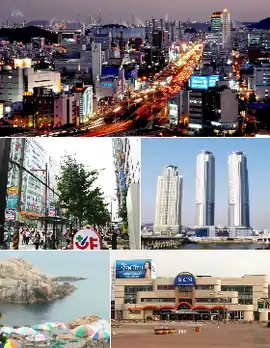 Top: View of downtown Yaeum-dong area Middle: Samsan-dong downtown area (left), Iaan Expodium Tower (right) Bottom: Ganjeolgot (left), Taehwagang Train Station (right) | |
 Flag 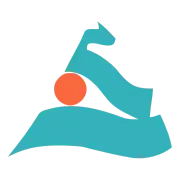 Seal of Ulsan | |
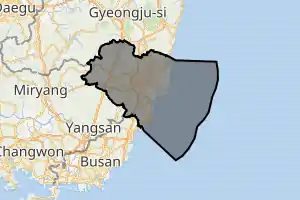
| |
| Country | |
| Region | Yeongnam |
| Districts | 5 (including 1 county) |
| Government | |
| • Type | Mayor–Council |
| • Mayor | Song Cheol-ho (Democratic) |
| • Body | Ulsan Metropolitan Council |
| Area | |
| • Total | 1,057.136 km2 (408.162 sq mi) |
| Population (October, 2014) | |
| • Total | 1,163,690 |
| • Rank | 8th Korea |
| • Density | 1,100/km2 (2,900/sq mi) |
| • Dialect | Gyeongsang |
| Area code(s) | +82-522 |
| ISO 3166 code | KR-31 |
| Flower | Pear flower |
| Tree | Ginkgo |
| Bird | White heron |
| GDP | USD $67.8 billion (2017) |
| GDP per capita (nominal) | USD $65,093 (IMF, 2017) |
| GDP per capita (PPP) | Int $80,058 (2017) |
| Website | |
Ulsan is the industrial powerhouse of South Korea, forming the heart of the Ulsan Industrial District. It has the world's largest automobile assembly plant operated by the Hyundai Motor Company;[2] the world's largest shipyard, operated by Hyundai Heavy Industries;[3] and the world's third largest oil refinery, owned by SK Energy.[4] In 2017, Ulsan had a GDP per capita of $65,093, the highest of any region in South Korea.
Administrative divisions
Ulsan is divided into four gu (districts) and one gun (county):
- Buk District (북구; 北區)
- Dong District (동구; 東區)
- Jung District (중구; 中區)
- Nam District (남구; 南區)
- Ulju County (울주군; 蔚州郡)
History
Stone tools found at the Mugeo-dong Ok-hyeon archaeological site indicates that Ulsan was inhabited by humans at least as early as the Paleolithic Era. Other findings indicated human inhabitation in the Neolithic Era. Ulsan also contains a substantial number of town remains from the Bronze Age.[5] During the Jinhan confederacy, Ulsan was a site of iron mining and production.[6] In the Later Silla period, Ulsan served as an important port for the economic hub of Gyeongju, and likely saw the import of luxury Persian goods such as silver, glass, and peacock tails.[7]
Records from the Joseon Dynasty show that Ulsan was developed as a shipbuilding site as early as 1642.[8]
Economy
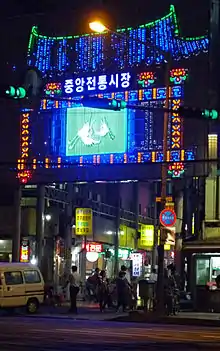
As the centre of the Ulsan Industrial District, the city is the corporate base of the multinational Hyundai conglomerate. Up to 1962, Ulsan operated as a fishing port and market centre. As part of South Korea's first five-year economic plan, Ulsan became an open port. Additionally, the government designated Ulsan as a Special Industrial District,[9] which encouraged development of major industrial plants and factories: an oil refinery, fertilizer plants, automobile production, and heavy industries were developed here. The shipbuilding port Bangeojin was annexed by the city in 1962.
Shipbuilding
Hyundai Group founded Hyundai Heavy Industries in Ulsan in 1973, which effectively turned the city into a company town and drew a large influx of workers into the city.[10] The company's importance to the city can be seen in its name's omnipresence, with a highway named after Hyundai's founder, and the hospital, school, theater, as well as many restaurants and department stores bearing the Hyundai name.[11]
Amid a global downturn in shipbuilding, Hyundai Heavy Industries sold $1 billion of assets and laid off large numbers of employees in 2016.[12] The company borrowed money from the state-run Korea Development Bank in order to purchase Daewoo Shipbuilding & Marine Engineering, forming Korea Shipbuilding & Offshore Engineering, with plans to move corporate headquarters to Seoul.[13] Some view this downturn as an indicator of South Korea's over-reliance on chaebols, and fear that a period of deindustrialization for Ulsan mirroring the United States' Rust Belt could be on the horizon.[14]
Petroleum
The city has the world's third largest oil refinery with 840,000 BPD, owned by SK Energy South Korea no.3 S-oil refinery complex with 669,000BPD and 1.7million PX plant of world single largest facility,39,000BPD lubricant base oil owned by Saudi Aramco is also in Ulsan.[4]
Automotive
Ulsan is the home of the world's largest automobile assembly plant of 300,000 annual capacity 5 assembly plants, proving ground and in-house peers, operated by Hyundai Motors started 50,000 capacity in 1968 now 30 times expansion of massive motor top complex in the world with own export piers with logistics competitiveness.[2] Its integrated design of related functions was inspired by the Ford River Rouge Complex in Dearborn, Michigan.
Lithium-ion battery manufacture
In November 2011, SB LiMotive opened an advanced lithium-ion battery production plant in Ulsan. SB LiMotive was a 50-50 consortium of Samsung SDI and Robert Bosch GmbH.[15][16][17] In September 2012, Samsung SDI purchased the Robert Bosch GmbH portion of SB LiMotive for $95 million to gain 100% ownership of the Ulsan production facility.[18] The Ulsan plant is one of Samsung SDI's trio of advanced car-battery production facilities. [19][20]
Transportation
The city transport department plans to build a light-rail line. The public transportation system is as good as any other major Korean city. The bus system shows a specific ETA at most bus stops.[21]
Ulsan Airport, constructed in 1970 and expanded in 1997, has more than 20 flights per day to and from Seoul's Gimpo International Airport and 4 flights per week to and from Jeju International Airport. In November 2010, Korea's high-speed train network, the KTX, was extended to Ulsan.[22] This provides a high-speed link to Seoul, with a running time of just over 2 hours. The new KTX station (Ulsan Station) is in nearby Eonyang, with a series of express buses (5001-5005), as well as some city buses serving the new station.[23] The original city station has been renamed Taehwa River Station.[22]
Sports
The city hosts the K League 1 football club Ulsan Hyundai FC. After the 2002 FIFA World Cup, they relocated from their former stadium in Jung-gu, which is now a municipal ground, to the Munsu Stadium, which hosted several matches during the 2002 World Cup. The club have been crowned champions of Asia twice, winning the AFC Champions League in 2012 and 2020. Ulsan was home to another football team, Ulsan Hyundai Mipo Dolphin FC, which played in the Korea National League until 2016, when it was dissolved.
It is also home to the University of Ulsan and its sports programs. Ulsan also hosts Korean Basketball League team Ulsan Hyundai Mobis Phoebus. Their home ground is Dongchun Gymnasium, which located in jung-gu ulsan.[24]
Geography
Ulsan is bounded on the east by the Sea of Japan. Busan is 70 km (43 mi) to the south.
Climate
Ulsan has a monsoon-influenced humid subtropical climate (Köppen Cfa/Cwa), with cold but dry winters, and hot, humid summers. Monthly means range from 2.0 °C (35.6 °F) in January to 25.9 °C (78.6 °F) in August, with diurnal temperature ranges generally low. Its location on the Korean peninsula results in a seasonal lag. The warmest days occur in August and averaging very near 30 °C (86 °F). Precipitation is relatively low in the winter months, but there is high rainfall from April to September.
| Climate data for Ulsan (1981–2010, extremes 1931–present) | |||||||||||||
|---|---|---|---|---|---|---|---|---|---|---|---|---|---|
| Month | Jan | Feb | Mar | Apr | May | Jun | Jul | Aug | Sep | Oct | Nov | Dec | Year |
| Record high °C (°F) | 19.3 (66.7) |
24.2 (75.6) |
25.4 (77.7) |
31.0 (87.8) |
34.7 (94.5) |
35.5 (95.9) |
38.2 (100.8) |
38.8 (101.8) |
35.6 (96.1) |
29.8 (85.6) |
27.5 (81.5) |
22.4 (72.3) |
38.8 (101.8) |
| Average high °C (°F) | 7.3 (45.1) |
9.2 (48.6) |
13.2 (55.8) |
19.2 (66.6) |
23.4 (74.1) |
26.0 (78.8) |
28.9 (84.0) |
30.0 (86.0) |
25.9 (78.6) |
21.9 (71.4) |
15.8 (60.4) |
9.9 (49.8) |
19.2 (66.6) |
| Daily mean °C (°F) | 2.0 (35.6) |
3.9 (39.0) |
7.9 (46.2) |
13.5 (56.3) |
17.9 (64.2) |
21.4 (70.5) |
25.0 (77.0) |
25.9 (78.6) |
21.5 (70.7) |
16.2 (61.2) |
9.9 (49.8) |
4.3 (39.7) |
14.1 (57.4) |
| Average low °C (°F) | −2.3 (27.9) |
−0.7 (30.7) |
3.2 (37.8) |
8.2 (46.8) |
12.8 (55.0) |
17.3 (63.1) |
21.8 (71.2) |
22.7 (72.9) |
17.9 (64.2) |
11.5 (52.7) |
5.1 (41.2) |
−0.3 (31.5) |
9.8 (49.6) |
| Record low °C (°F) | −14.3 (6.3) |
−12.5 (9.5) |
−9.6 (14.7) |
−2.6 (27.3) |
3.6 (38.5) |
6.8 (44.2) |
13.9 (57.0) |
13.4 (56.1) |
7.9 (46.2) |
0.4 (32.7) |
−7.8 (18.0) |
−12.4 (9.7) |
−14.3 (6.3) |
| Average precipitation mm (inches) | 34.3 (1.35) |
42.6 (1.68) |
65.8 (2.59) |
91.1 (3.59) |
108.1 (4.26) |
176.8 (6.96) |
232.3 (9.15) |
240.3 (9.46) |
168.2 (6.62) |
53.5 (2.11) |
41.1 (1.62) |
23.0 (0.91) |
1,277.1 (50.28) |
| Average precipitation days (≥ 0.1 mm) | 5.3 | 6.3 | 8.1 | 8.4 | 9.2 | 10.0 | 13.5 | 12.1 | 10.3 | 5.7 | 5.1 | 3.9 | 97.9 |
| Average snowy days | 1.7 | 2.1 | 1.1 | 0.0 | 0.0 | 0.0 | 0.0 | 0.0 | 0.0 | 0.0 | 0.1 | 1.1 | 6.1 |
| Average relative humidity (%) | 49.6 | 51.9 | 57.6 | 60.3 | 66.1 | 73.3 | 78.9 | 77.7 | 75.7 | 67.2 | 59.9 | 52.4 | 64.2 |
| Mean monthly sunshine hours | 190.7 | 176.4 | 187.5 | 207.2 | 215.4 | 172.7 | 151.5 | 167.3 | 150.0 | 193.7 | 182.0 | 194.6 | 2,188.8 |
| Percent possible sunshine | 61.2 | 57.4 | 50.6 | 52.8 | 49.5 | 39.6 | 34.2 | 40.0 | 40.3 | 55.3 | 58.8 | 64.0 | 49.2 |
| Source: Korea Meteorological Administration[25][26][27] (percent sunshine and snowy days)[28] | |||||||||||||
Tourist attractions
Yeongnam Alps
There are seven tall mountains (Gajisan, Sinbulsan, Ganwolsan, Cheonhwangsan, Yeongchuksan, Goheonsan, Jaeyaksan) over 1,000m above sea level. Sinbulsan (MT.) Ridge, where grasses turn silver in autumn, is one of the best sights to see in the Yeongnam Alps. Eoksae festival is held every early October in Ganwoljae, which is best known for its colony of silver grass.
Oegosan Onggi village
Korea's largest traditional folk Onggi (earthware) village is Oegosan. The traditional Onggi (earthware) manufacturing process is carried on here and is open to tourists, including Onggi workshops and kilns. The Ulsan Onggi museum offers a variety of information related to Onggi and displays a diversity of this earthware.
Jangsaengpo Whale museum & Whale Ecological Experience Hall
As the only whale museum in Korea, Jangsaengpo whale museum collects, maintains and displays whaling-related artifacts. They have become more rare since 1986, when whaling was internationally prohibited in order to protect the species. The museum provides a variety of information related to whales and marine ecosystems; it is a space for education, research and experience. Whale cruises depart from Jangsaengpo port.
Grand Parks
- Ulsan Grand Park: This is claimed as the best ecology park in a downtown area in Korea, boasting a vast area of 3,640,000 m2 (39,180,634 sq ft). "Natural, Clean and Comfortable" are the main themes, and it is a place for urbanites to seek nature. It sponsors a variety of events and festivals for families. it is a pleasant place for relaxation where you can breathe in nature during daily life. In particular, the Rose Festival every June presents a feast for the eyes and nose.
- Taehwagang River Grand Park : Simnidaesup (bamboo grove), one of the 12 scenic beauties of Ulsan, was restored; now the river and the bamboo grove are connected. This space expresses the related ecology of the area, showing the importance of nature and environment. It allows visitors the chance to observe and experience wildlife in its natural environment and to relax while being one of nature.
Industrial tour
Ulsan Industry Park has been leading the Pacific Rim industry in the 21st century. Ulsan has Hyundai Motor Company, with the world's largest single-purpose plant; Hyundai Heavy Industries, the biggest heavy industry leader in the world; Hyundai Mipo Shipbuilding, and Petrochemical Park, leaders in Korea's chemistry industry.
Coast trip
Ulsan has beautiful beaches (Jinha, Ilsan). Daewangam Park features a lush, hundred-year-old pine forest. Ganjeolgot Cape is noted as the first place to see the sunrise from the Korean peninsula. A sunrise festival is held every New Year's Day.
 Twilight view of Taehwa River and downtown area
Twilight view of Taehwa River and downtown area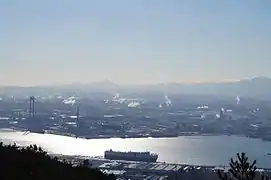 Industrial Complex area in Ulsan
Industrial Complex area in Ulsan
Festival
April: Seo Duk-chul's creative theme
In media
Ulsan is one of the filming locations of the Munhwa Broadcasting Corporation 2012 South Korean television melodrama series May Queen, starring Han Ji-hye, Kim Jae-won, and Jae Hee.
Twin towns – sister cities
| City | Region | Country | Year |
|---|---|---|---|
| Hagi | Yamaguchi Prefecture | 1981 | |
| Portland | Oregon | 1987 | |
| Changchun | Jilin | 1994 | |
| Kocaeli Province | 2002 | ||
| Santos | São Paulo | 2002 | |
| Khánh Hòa Province | 2002 | ||
| Tomsk | Tomsk Oblast | 2003 | |
| Wuxi | Jiangsu | 2006 | |
| Montevideo | Montevideo Department | 2012 | |
| Chennai | Tamil Nadu | 2016 | |
| Mandalay | Mandalay Region | 2017 |
Notable people
- Kim Young-chul, comedian and singer
- Kim Tae-hee, actress
- Han Chae-ah, actress
- Oh Yoon-ah, actress
- Raina, singer (After School and Orange Caramel)
- Tei, singer
- Seo In-guk, singer and actor
- Yura, singer (Girl's Day)
- Jang Ki-yong, model and actor
- Kim Mingyu, actor and former Produce X 101 contestant
See also
References
- "SOUTH KOREA: Cities (registered population)". Citypopulation. Retrieved 21 August 2013.
- 연합뉴스 : 바른언론 빠른뉴스 (in Korean). Yonhap News. 2009-10-16. Retrieved 2013-07-12.
- 천혜 절경 바닷가가 세계 최대 조선소로 변모 - 오마이뉴스. Ohmynews.com. 2013-01-18. Retrieved 2013-07-12.
- http://pda.ulsan.go.kr/Common/Detail.neo?id=U0010711%5B%5D
- Su-Il, Jeong (2016). The Silk Road Encyclopedia. Irvine, CA: Seoul Selection. ISBN 978-1624120664.
- "Iron Culture of Ancient Korea". Korean Heritage. Cultural Heritage Administration. Retrieved 25 October 2019.
- "Gyeongju". Silk Roads. UNESCO. Retrieved 25 October 2019.
- "Port of Ulsan review". World Port Source. World Port Source. Retrieved 25 October 2019.
- Jacobs, A. J. (2 November 2011). "Ulsan, South Korea: A Global and Nested 'Great' Industrial City" (PDF). The Open Urban Studies Journal. 4: 8–18. Retrieved 25 October 2019.
- Yeon-Soo, Kwak (8 May 2019). "Hyundai Heavy hit by protest from Ulsan". The Korea Times. Retrieved 25 October 2019.
- Evans, Stephen (30 May 2015). "Heavy metal: Life at the world's largest shipyard". BBC News. Retrieved 28 October 2019.
- In-Soo, Nam (9 May 2016). "Hyundai Heavy Industries to sell $1 billion in assets, cut jobs as orders slump". MarketWatch. The Wall Street Journal. Retrieved 25 October 2019.
- Yeon-Soo, Kwak (9 May 2019). "Hyundai Heavy hit by protests from Ulsan". The Korea Times. Retrieved 28 October 2019.
- Jin, Hyunjoo (12 August 2018). "Empty shipyards and suicides as 'Hyundai Town' grapples with grim future". Reuters. Retrieved 28 October 2019.
- "SB Limotive Starts Production of Lithium-Ion Cells". EngeryTrend. November 11, 2010. Archived from the original on 2017-10-02. Retrieved May 15, 2017.
- Lee, Eun-joo (November 10, 2010). "SB LiMotive starts lithium-ion battery plant". Korea JoongAng Daily. Retrieved May 15, 2017.
- Kim, Tae-gyu (June 13, 2011). "Bosch plans to expand joint venture with Samsung". Korea Times. Retrieved May 15, 017.
- "Bosch and Samsung SDI disbanding the SB LiMotive Li-ion joint venture". Green Car Congress. September 5, 2012. Retrieved May 15, 2017.
- "SB Limotive Starts Production of Lithium-Ion Cells". Energy Trend. November 11, 2011. Archived from the original on 2017-10-02. Retrieved May 15, 2017.
- Morris, Charles (March 9, 2015). "Sources say Samsung to provide battery packs for BMW X5". Charged. Yonhap. Retrieved May 15, 2017.
- "Welcome to Ulsan Metropolitan City - News and Notice". Ulsan City Council. Archived from the original on 2008-01-03. Retrieved 2008-02-18.
- Ulsan-Seoul high-speed train service to start in November. Koreatimes.co.kr (2010-10-05). Retrieved on 2013-07-12.
- "Archived copy". Archived from the original on 2012-07-16. Retrieved 2010-12-10.CS1 maint: archived copy as title (link)
- ulsan mobis phoebus basketball team, ulsan mobis phoebus basketball team (2016-04-14). "ulsan mobis phoebus basketball team".
- 평년값자료(1981–2010) 울산(152) (in Korean). Korea Meteorological Administration. Retrieved 23 December 2016.
- 기후자료 극값(최대값) 전체년도 일최고기온 (℃) 최고순위, 울산(152) (in Korean). Korea Meteorological Administration. Retrieved 23 December 2016.
- 기후자료 극값(최대값) 전체년도 일최저기온 (℃) 최고순위, 울산(152) (in Korean). Korea Meteorological Administration. Retrieved 23 December 2016.
- "Climatological Normals of Korea" (PDF). Korea Meteorological Administration. 2011. p. 499 and 649. Archived from the original (PDF) on 7 December 2016. Retrieved 23 December 2016.
- "Ulsan Metropolitan City". ulsan.go.kr. Archived from the original on 2014-01-03.
- "Mandalay and Ulsan". Archived from the original on 2017-09-16.
External links
| Wikimedia Commons has media related to Ulsan. |
| Wikivoyage has a travel guide for Ulsan. |
- Ulsan Metropolitan City official site (in English)
- Ulsan Metropolitan City official site (in Korean)
- Ulsan : Official Site of Korea Tourism Org
- Ulsan's Foreigner Living Site
- "2015년 인구주택총조사 전수집계결과 보도자료" [2015 Population and Housing Census]. Statistics Korea.
